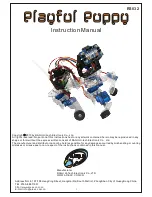
4
Solar
Cell
0.33F
Capacitor
2N3904
2N3906
2.2 kOhm Resistor
Motor
3
2
1
1381
When the circuit starts charging, the 2N3904 transistor is off, so the current can’t go
through the motor back to the solar cell. Instead, it charges the storage capacitor. While this
is happening, the 1381 monitors the voltage climb through its pins 2 and 3. When the
voltage level matches a preset point in the 1381, it sends a pulse out to the 2N3904 tran-
sistor, turning it on. As soon as it turns on, some power splits off through the 2.2k resistor
and goes into the 2N3906 transistor. This transistor keeps the 2N3904 on even when the
1381 turns back off, and keeps the whole circuit running until the power runs out.
Construction - Soldering
The most important skill needed to successfully construct your device is soldering. Make
sure you start by using
electronics solder,
not
plumber’s solder. The main trick to getting a
successful solder connection is to heat the junction up before applying the solder to the heated
area. Do NOT try to melt some solder onto the tip of the iron and smear it onto the joint - you
won’t get a strong joint.
If the heat is applied unevenly, you will get solder blobs (see below). To better apply heat,
keep your soldering iron tip clean by wiping it frequently on a damp sponge or cloth. The tip
should always be shiny, and not covered in burned flux.
Solder
Soldering Iron
PCB Solder Pad
PCB
Component Leg
Bad
No flow from leg to pad
Good
Flows from leg to pad
Bad
Solder “bridge” across pads
Bad & Good Solder Joints
X
X
á

























